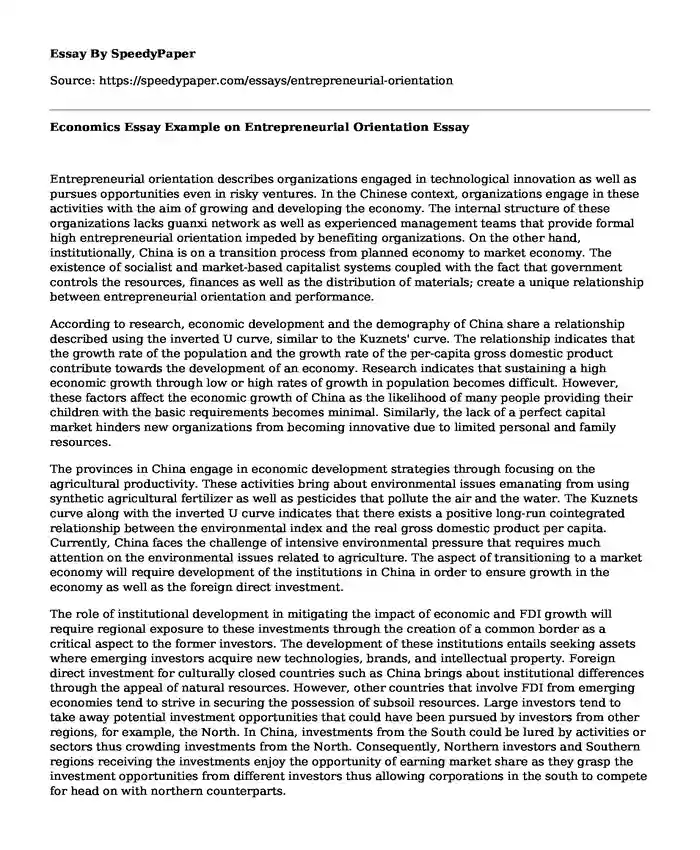Entrepreneurial orientation describes organizations engaged in technological innovation as well as pursues opportunities even in risky ventures. In the Chinese context, organizations engage in these activities with the aim of growing and developing the economy. The internal structure of these organizations lacks guanxi network as well as experienced management teams that provide formal high entrepreneurial orientation impeded by benefiting organizations. On the other hand, institutionally, China is on a transition process from planned economy to market economy. The existence of socialist and market-based capitalist systems coupled with the fact that government controls the resources, finances as well as the distribution of materials; create a unique relationship between entrepreneurial orientation and performance.
According to research, economic development and the demography of China share a relationship described using the inverted U curve, similar to the Kuznets' curve. The relationship indicates that the growth rate of the population and the growth rate of the per-capita gross domestic product contribute towards the development of an economy. Research indicates that sustaining a high economic growth through low or high rates of growth in population becomes difficult. However, these factors affect the economic growth of China as the likelihood of many people providing their children with the basic requirements becomes minimal. Similarly, the lack of a perfect capital market hinders new organizations from becoming innovative due to limited personal and family resources.
The provinces in China engage in economic development strategies through focusing on the agricultural productivity. These activities bring about environmental issues emanating from using synthetic agricultural fertilizer as well as pesticides that pollute the air and the water. The Kuznets curve along with the inverted U curve indicates that there exists a positive long-run cointegrated relationship between the environmental index and the real gross domestic product per capita. Currently, China faces the challenge of intensive environmental pressure that requires much attention on the environmental issues related to agriculture. The aspect of transitioning to a market economy will require development of the institutions in China in order to ensure growth in the economy as well as the foreign direct investment.
The role of institutional development in mitigating the impact of economic and FDI growth will require regional exposure to these investments through the creation of a common border as a critical aspect to the former investors. The development of these institutions entails seeking assets where emerging investors acquire new technologies, brands, and intellectual property. Foreign direct investment for culturally closed countries such as China brings about institutional differences through the appeal of natural resources. However, other countries that involve FDI from emerging economies tend to strive in securing the possession of subsoil resources. Large investors tend to take away potential investment opportunities that could have been pursued by investors from other regions, for example, the North. In China, investments from the South could be lured by activities or sectors thus crowding investments from the North. Consequently, Northern investors and Southern regions receiving the investments enjoy the opportunity of earning market share as they grasp the investment opportunities from different investors thus allowing corporations in the south to compete for head on with northern counterparts.
The development of institutions in these sections allows mitigation of the impacts of economic and FDI growth as it allows investments from all regions to develop the institutions within the nation through the available resources. It also enables prediction of the possible effects of involving foreign direct investment thus controlling the environmental issues. Therefore, China should focus on improving the employment rates in order to boost the gross domestic product. These factors will contribute towards increasing the imports and exports as well as lower local government expenditure thus facilitating growth in the economy.
Cite this page
Economics Essay Example on Entrepreneurial Orientation. (2019, Jun 04). Retrieved from https://speedypaper.com/essays/entrepreneurial-orientation
Request Removal
If you are the original author of this essay and no longer wish to have it published on the SpeedyPaper website, please click below to request its removal:
- Free Essay on Impact and Importance of Technology
- Free Essay on the Roles of Equal Employment Opportunity Commission
- Inconsistencies and Tensions of Marxism and Communism, Essay Example
- Essay Sample on Income, Wealth and Health
- Article Review: Trump Threatens Tariffs on All Imports From China; Escalating Trade Feud
- Free Essay Answering the Questions about Information Systems
- In the modern global economy, both diversity and inclusion have increasingly become essential concepts that play a prominent role in the field of human resources, enhancing successful organizational management. The current popularity of the two aspects among different organizations primarily stems considerably from the augmented resources for operational competitiveness in the context of a continually changing and globalizing economy (Andresen, 2007). Diversity is adequately described as any feature that is substantially used to distinguish various groups of individuals from each other. In a nutshell, the difference within an organization is primarily concerned with empowering individuals by appreciating the multiple aspects that makes them different for example national origin, ethnicity, age, and education.
Popular categories





